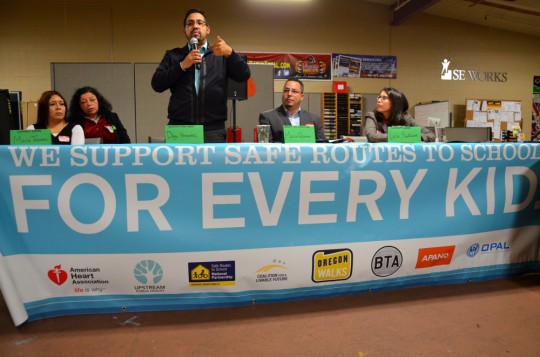
(Photos: M.Andersen/BikePortland)
Portland’s largest biking advocacy group has, for the first time, created a written policy to help it fight racial disparities in transportation.
“The reality of Portland is that while we are one of the whitest cities in America, it’s not going to be a white city forever.”
— Rob Sadowsky, BTA
As the most bikeable areas of Portland grow even whiter and many less bikeable areas grow even more diverse, the group says it needs to focus more on building “a community where everyone from all racial backgrounds has access to safe, healthy, and affordable transportation options.”
“The reality of Portland is that while we are one of the whitest cities in America, it’s not going to be a white city forever,” Executive Director Rob Sadowsky said Wednesday. “Over half of Portland Public Schools students already are students of color.”
(Update 2:50 p.m.: Looks like Sadowsky was about 6 percentage points off: 44 percent of PPS students identify as something other than white. “I got it from the Coalition for Communities of Color and just trusted them,” he writes. “The gist of point remains the same.” It’s also worth noting that David Douglas students who live in Portland might push the citywide white public school student population under 50 percent. Thanks to commenters Random and Daisy for getting us straight on this.)
This new focus is arriving alongside what’s probably the BTA’s single biggest campaign at the moment, the For Every Kid effort to convince Metro to dedicate a share of its federal money to a region-wide Safe Routes to School program.
At a meeting near the Portland/Gresham border Tuesday night, the BTA teamed up with the Community Alliance of Tenants to give speakers of five different languages a chance to talk about their desire for streets safe enough to comfortably walk and bike on: streets with more lighting, more stoplights and fewer drunk drivers.
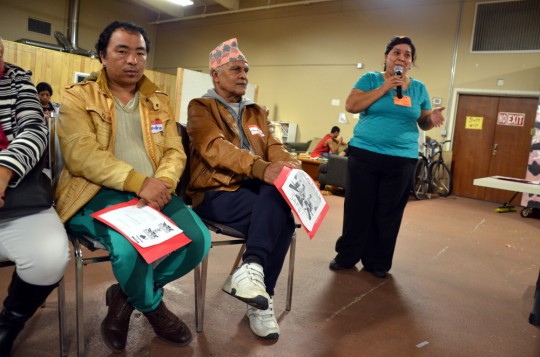
“Our solutions for ‘make big streets safe’ in East Portland, they look very different from what we’re looking for on Barbur,” Sadowsky said.
The “Racial Equity Policy Statement” approved by the BTA’s board includes this passage:
• We have not consistently stood with culturally and community-based organizations in countering displacement caused by gentrifying investments including bikeway improvements.
• Our organization and our movement have not done enough to listen to the concerns and priorities of communities of color.
• With more than 50% of youth in our schools being people of color, we cannot afford for these inequities to persist and for an increasingly smaller percentage of our community members to share in community prosperity.
• We know that diversity in cycling exists and the number of people of color biking continues to grow. People of color are leading the US biking boom.
• Metro’s Regional Active Transportation Plan found that “in the 4-county region, nonwhite householders make a greater percentage of their trips by walking, bicycling and transit than white householders.”
Advertisement
To get these goals done, Sadowsky said the BTA will recruit a diversity task force that includes people both on and off its staff and create an “action plan with clear accountability and metrics, including prioritizing budget allocations and staffing, which will result in measurable results on a yearly basis towards achieving action plan goals.”
Elizabeth Quiroz, a member of the BTA’s four-person advocacy team, now has the additional title of equity manager. She said that the BTA’s approach to more equitable advocacy is mostly about changing its processes for selecting policy priorities, since its current staff and volunteer base don’t necessarily know what communities of color need and want.
“We realize that we’re not experts,” Quiroz said Thursday. “There’s a lot of disparities, a lot of transportation burdens, and they’ve been distributed unequally, specifically in communities of color. … A lot of these groups haven’t really been at the table, haven’t been part of the decision-making.”
Quiroz said that as part of the BTA’s effort, it’s “looking to our other colleagues like the CCC that have advanced more in this work.”
Sadowsky said that many white-dominated nonprofits have a tendency to “stand outside of the community, on the other side of the fence, and throw things in.”
“Our role is not to throw solutions over the fence,” he said. “Our role is to open that gate so solutions go both ways, and to listen, first and foremost, to what communities want.”
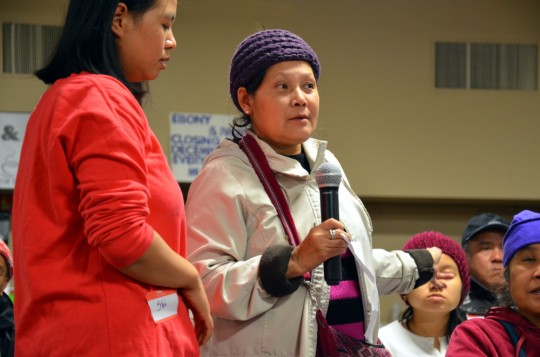
He said the BTA’s spending some of its energy trying to ensure that its work benefits people of color will also ultimately make the group better at making biking better for white people.
“Just from a survival mode, it makes sense,” Sadowsky said. “But it feels right. It’s exciting. It’s almost reinvigorated some of our staff’s energy. … People used to say, ‘Oh, that’s east of 82nd Street, I’m not gonna live there.’ People are all of a sudden saying, ‘I’m going to have to live there because I can’t afford to live anywhere else.'”
Correction 12:45 p.m.: A previous version of this post gave the wrong school affiliation for Diego Hernandez. Also at 12:45 p.m.: Added comments from Quiroz.
— Michael Andersen, (503) 333-7824 – michael@bikeportland.org


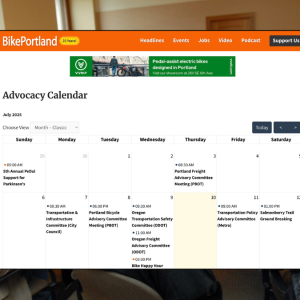

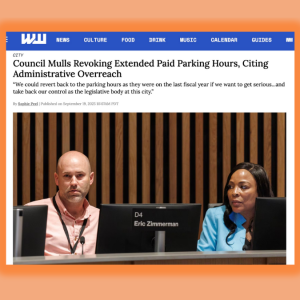
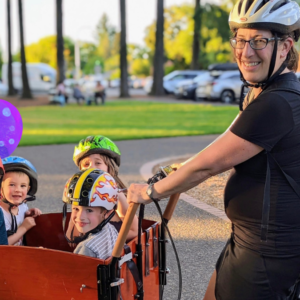
Thanks for reading.
BikePortland has served this community with independent community journalism since 2005. We rely on subscriptions from readers like you to survive. Your financial support is vital in keeping this valuable resource alive and well.
Please subscribe today to strengthen and expand our work.
““Over half of Portland Public Schools students already are students of color.”
Where does that come from? According to PPS, in 2014, 55.9% of the students are white (up from 55.6% in 2012).
Is PPS counting Russian students as “students of color” again?
Yeah, okay, so the percentage is slightly less than half rather than more than half, if we’re talking about PPS alone. But the overall trend is that the white population of PPS is declining as a percentage. In 2001, white students were 61.5% of PPS. And in that same period, from 2001 – 2014, the Hispanic population grew from 10.2 to 16.2%. (See page 18 of this PPS enrollment report: http://www.pps.k12.or.us/files/data-analysis/PPS_Enrollment_Report_2014-15_v3.pdf)
So, actual fact: PPS is majority white, but, if overall trends continue, may not be majority white for long.
This parsing of statistics is also not quite relevant to the BTA’s overall message, which is that they’ve too long ignored important parts of the population of folks who bike and who might bike. I’m glad to see them making this shift in their approach.
“So, actual fact: PPS is majority white, but, if overall trends continue, may not be majority white for long.”
LOL. The percentage of white students in PPS bottomed out at 54.2% in 2009, and has been rising since then.
The Hispanic student population in PPS has risen from 10.2% to 16.2% since 2001, but that is offset by the black student population falling from 16.5% to 10.3%.
It’s just that Sadowski is repeating a popular bureaucratic/advocate meme that although Portland may seem almost lily-white from the vantage point of the Hawthorne District, a huge unstoppable minority wave is going to crash into Portland, and utterly transform the demographics of the city (including the portion of the city west of 82nd).
Facts not in evidence.
BTA’s equity statement is more general: “With more than 50% of youth in our schools being people of color…”
So Sadowsky said PPS rather than area schools — oops. But overall this move by the BTA is right on.
“So Sadowsky said PPS rather than area schools — oops.”
No, the claim that half the students in PPS are “people of color” is quite common – it wasn’t a misstatement.
The City of Portland, Bureau of Planning and Sustainability:
“Portland City Council Adopts New Climate Action Plan
FOR IMMEDIATE RELEASE
June 24, 2015”
…
“Portland is changing. More than half of the students in Portland Public Schools, for example, are people of color.”
Hey, why let the facts get in the way of a good narrative?
You’re right, Random – looks like Sadowsky was wrong on this by several percentage points. I’ll correct. In the meantime, here’s a useful historical chart.
http://static1.squarespace.com/static/5501f6d4e4b0ee23fb3097ff/t/556d37e9e4b031a6bf436c97/1433221097134/AN-UNSETTLING-PROFILE.pdf#page=29
Funny, I was just reading that document last month – not that the Slavic community in Portland doesn’t have problems, but defining them as People of Color is a bit – idiosyncratic – to Portland.
And is not merely that Sadowsky was wrong – as I noted, the City of Portland uses the same incorrect factoid. It would be interesting to know where it came from, since people seem to use it as a useful talking point.
“Is PPS counting Russian students as “students of color” again?”
Maybe. Remember, a 100 years ago, groups like the Irish and Italians weren’t thought of as white.
Does anyone think that Russians aren’t white?
I just think it is hilarious – there is a planning/bureaucratic constituency in Portland devoted to claiming that Portland is really a very, very diverse city – and if they have to claim that the Slavic community in Portland are “people of color” in order to get the number of claimed minorities up, they are prepared to do that. (Claiming that Russians are POC is unique to Portland, I think.)
Actual fact: Portland Public Schools are majority white, and getting whiter. (The percentage of blacks in PPS has dropped from 11.4% in 2012 to 10.3% in 2014.)
Obviously, if you throw David Douglas into the mix, things get a bit more diverse (although David Douglas High is still 42% white), but Sadowsky was claiming majority-minority status for PPS.
I’m pretty sure school race/ethnicity categories are self-identified, which IMO is the only sensible way to racially identify large groups of people. So folks of Russian ethnicity would count as “white” if they checked “white” for themselves, but some might also check “Asian” or something else.
I was happy to see the fastest growing segment was multi-racial. That’s really our way out of the backwards idea of races: find the your opposite shade on the color wheel and make tons beautiful babies with them. Within a generation or two we all be so half this, quarter that, smidge whatever, we won’t care anymore. Seriously, people, “race” is concept that can not die fast enough.
Well, of course, with the Portland city government actively violating federal law as it operates as a Sanctuary City, Portland will become more diverse. Whether that kind of diversity, poor, uneducated, and unskilled is what we want is not discussed at all. Because, you know, even thinkingbabout protecting our borders and managing immigration is racist.
All in all here… Is it really racial discrimination that closer-in, more densely populated areas see more cycling infrastructure improvements?
These types of disparate impact-based issues are not evidence of discrimination. They don’t reveal “inequities”, either. Sure, they show something, but nothing very meaningful.
Yes, it is, and it goes well beyond just cycling infrastructure.
It is? How so?
See my reply to you below for some background.
http://www.thedailybeast.com/articles/2015/08/03/exploding-the-myth-of-sanctuary-cities.html
http://www.immigrationpolicy.org/special-reports/debunking-myth-sanctuary-cities
This is fantastic, exciting news. Thanks, BTA! I’ve let my membership lag because I haven’t been as enthusiastic about some of their approaches of late, but this is an exciting direction and I’m going to renew now.
Just a few thoughts on this comment:
Where did “protecting our borders” come from? We’re talking about Portland residents.
There’s bias in who gets called unskilled.
If I live in multifamily housing in East Portland and look at cycling infrastructure in my neighborhood versus Central Eastside or Lloyd District, I don’t think population density explains what I see. I don’t think I would need scare quotes around “inequities.”
Oops, this should have been a reply to BeavertonRider, sorry.
The BTA is telling us that one of it’s justifications for this new approach is the changing ethnic composition of the local population. I cited a primary reason for that change.
And, of course, there’s bias in calling some unskilled, under-skilled, and skilled. So what? This type of bias reflects real differences between people that are meaningful and important. Are you saying it’s unfair or hurtful to correctly identify real competency differences between people?
“If I live in multifamily housing in East Portland and look at cycling infrastructure in my neighborhood versus Central Eastside or Lloyd District, I don’t think population density explains what I see. I don’t think I would need scare quotes around “inequities.””
You don’t think so? Why not? A hunch? Instinct? Or is a disparity by itself sufficient to declare racism and discrimination?
Much more than a hunch:
Bleeding Albina a History of Community Disinvestment 1940-2000
East Portland: a city audit
Oregon Was Founded as a Racist Utopia
Steve, okay, how does this explain the disparity we’re actually talking about? Also, to date, I failed to acknowledge just how racist this liberal town is. Thanks for enlightening me to this characteristic of Portland liberalism.
BR,
Discrimination is normally a good thing. What is discrimination? Discrimination is the recognition of differences between things, many times learned through experience.
If you see a person standing on the street corner whacking people with a machete, it is good to “discriminate” and avoid that person and/or corner.
Jesse Jackson tells the story of being embarrassed when, late at night walking down the street, he hears foot steps approaching from behind; when he turns around he is relieved because he sees a white person. Jesse discriminates based on his experience in the world – he knows based on experience that most whites are not out to “get” him. It’s common sense.
Almost all work is “skilled.” It’s in the eye of the beholder–my cardiologist is “unskilled” compared to some of the Wall Street MBA social parasite types if viewed in a particular light.
I think the goal for 100% access to safe routes to school is strong enough to stand on its own, without tying it to racial or economic disparities.
It is, indeed. You have to wonder why the reach is made to justify safe routes or protected bike lanes to racism/discrimination or “for the children” memes. This things have legitimate justifications behind them without the coded allegations of discrimination.
I agree with you so often in these comments that I’m really wondering why we have such different takes on this. Why is it bad to acknowledge the least privileged and most underserved among us? The cycling community in particular is dominated by white men. The BTA statement acknowledges the blindspots that have resulted from this and seeks to change their approach to do better.
See, the problrm I have is the intellectual premise underlying this new approach. It rests on this new faddish socio-economic model of “privilege”. It pretends that any observed disparity is the result of someone else imposing their “privilege” or racism onto someone else. It’s bunk and it serves only to guilt others into doing something or adopting a viewpoint they otherwise might not. It’s a destructive and divisive approach that’s simply unneeded whrn talking about building safe bike infrastructure.
BeavertonRider,
In my opinion the growing awareness of the concept of “privilege” is not a fad at all. At least I hope it’s not.. because from my experience the only way to get our heads around the very complicated issue of race in America is to first be as fully aware as possible of how our existing place in society is the result of nothing other than the color of our skin.
Im not saying that being aware of the concept is a “fad”. I am saying the entire concept itself is a “fad”. It merely lumps all white people together – many of whom cannot be considered “privileged” by any reasonable standard – and points an accusatory finger at them asserting, “you don’t deserve what you have” and “you did this”.
It is, at bottom, just another way to complain about stereotyping, even though all racial groups face stereotyping and there’s nothing new or remarkable about it. Playing this particular race card suggests that racial disparities are due solely to racial simpliciter. It is, in other words, all whites must accept blame for all disparities of any kind. That’s all.
It’s not some deep philosophical or scientific perception into how humans work.
I have to wonder, too, is this privilege dynamic only at play in white America?
To me the idea of privilege is simply about awareness. I think it’s important to stop and look inside ourselves and really examine how our skin color, class, and so on, impacts our default assumptions about other people, society in general, the issues, etc.
Well, I guess this is where we differ, Jonathan. I dont maintain default assumptions about people or society.
I see what you did there BeavertonRider. What i was trying to explain was that I believe privilege is a real thing that has a major impact on how I see the world around me. Whether I want it to or not, it puts me at a particular starting point for how I see the world.
All I’m saying is that through experiences and some re-training of my brain I’ve gotten a little better about understanding the impact of my privilege and then being conscious of how it influences my thoughts/words/actions.
I might be getting off on a tangent here. sorry about that. it’s just that your assertion that “privilege” is some trend or fad really raised an eyebrow for me.
thanks for commenting.
Is it only at play in America? If you visit Brazil, you will get your answer.
Ooops sorry… I misread your question.
Possibly relevant information that didn’t make it into this post: the BTA isn’t claiming that racial inequity is the only kind of inequity — indeed, Sadowsky said explicitly that it’s not. He said they’re grappling with racial equity with this initiative because they feel it’s maybe the hardest/thorniest of the many inequities in our lives and therefore would be easy to procrastinate on if it weren’t addressed first.
JM,
Perhaps you work for racists, or know people who do, who put people in good positions based solely on the color of their skin. But most people I know got their position based mostly on the knowledge they gained thru hard work, education,etc. They made choices to do the right thing. Your comment “……..to first be as fully aware as possible of how our existing place in society is the result of nothing other than the color of our skin” has no merit of any kind anywhere in this nation. It is an insult to people who have worked very hard and done the right thing to get where they are, and is an insult to MLK himself – go back and listen to his “I have a dream” speech! I’ve seen many white folks make bad choices that resulted in bad outcomes – you can just walk down the street on any day and see some of them in Portland.
Hello Kitty, I’d encourage you to read the full statement, which makes a strong case for this focus. https://btaoregon.org/wp-content/uploads/2015/11/BTAEquityPolicy.pdf
Why would we not want to tie in SR2S work with the realities of racial and economic disparities?
Because it is unnecessary. The goal does not need justification.
Everyone should have a safe route to school.
Yes, everyone should have a safe route to school. The question, given limited resources, is who has the greatest need for them and who should get them first?
That is a very different question, and one where demographics would have a role to play. If I were answering that question, I would start with “where is the greatest need?”
and i think sadowsky’s point was greatest need to some extent corresponds with demography.
In my community, BTA is irrelevant. I approached our local schools and provided the safe routes information and helped run their “bicycle safety rodeo” events. We did it on our own. Way to go Westridge! 4years of successful bike rodeos! BTA…not so good
It’s not bad to acknowledge any number of disparities we have in our society.
In this case, I think it dilutes the message. 100% access to safe routes to school is Good. Period. It is not a goal that is only good for racial/economic reasons.
Ooops… that was for Daisy.
Fantastic work by the BTA.
I think noting the historic disparities and inequities (and privilege, no quotation marks) makes the statement stronger. Existing discriminatory power and privilege structures and norms and their outcomes continue, in part, because of silence about the underlying power structure and history of racism and classism.
By clearly recognizing and reminding ourselves how we got where we are, we are able to more effectively change our course.
Okay, for this to be true, did the current disparity in infrastructure emerge before of after new minorities moved in?
I keep reading how these neighborhoods were once white olaces and now they’re becoming increasingly ethnically and racially diverse. So, did the perceived disparity arise before or after minorities became a larger part of the local population? It would seem to me that if such a disparity exists and that disparity exists because the area has lots of minorities, then an awfully rapid transformation of the city’s infrastructure occurred. And I just don’t see that having happened… Maybe it has. My thought is that if a disparity exists it was born before the area saw the shift from white to more minority. Maybe I am wrong? Id like to see some actual data in this and not the usually wrong and bad faith gut reactions to observed disparity.
disparities might arise because improvements are focused here and not there — not because something that was okay got worse. also some of the increased diversity in some areas results from displacement by gentrification.
or, hey, a bunch of illegals jumping the border.
I think a fairer reading of his comment would be that he is suggesting that the infrastructure shortcomings in East Portland may exist for historical reasons that have nothing to do with race, and may have developed while that area was predominantly white (if in fact it was, which I don’t know for certain). That East Portland is now more diverse may be as a result of (or coincidental to) that lack of infrastructure investment, which kept property values down, and made it a more attractive location for people pushed out of other neighborhoods.
Thank you, Evan. This work is deeply important to us as an organization, to our ability to evolve our agenda, and to the strength of our movement.
I wasnt being clevet or attempting to be. I just dont have default assumptions about people. And I try not to arrogantly believe that my experiences and knowledge is shared by everyone else.
But I think what’s hapoening here is you’re recasting the privilege concept as something it is not. The privilege concept does not merely suggest that we avoid oir individual experiences as being shared by all. Rather, the concept tells us that all white people have power and that this power is used to hurt others (either by denying them something or taking something away).
So we’re not talkimg about the same thing here. Youre talking about avoiding letting your experiences be the only experience you consider. Thats admirable, but that’s not what the privilege concept is about.
“It is, in other words, all whites must accept blame for all disparities of any kind.”
“Rather, the concept tells us that all white people have power and that this power is used to hurt others (either by denying them something or taking something away).”
“It pretends that any observed disparity is the result of someone else imposing their “privilege” or racism onto someone else.”
You’re reading way too much into the privilege model, and you seem extremely defensive about it. As a white person, I’m grateful for the work on privilege for educating me about how race works in our society, something most white people are oblivious to. I don’t feel personally attacked by people pointing out that, on average, blacks face more obstacles than whites in achieving their goals, so why should you?
It’s been depressingly easy to demonstrate that blacks face significantly more obstacles to success than whites. Have you read the study “Are Emily and Greg More Employable than Lakisha and Jamal? A Field Experiment on Labor Market Discrimination”? It shows that it’s much easier for a person with a white-sounding name to get a job interview than a person with a black-sounding name, with resumes that are otherwise identical.
Another study showed that white men with felony convictions found employment more easily than black men with clean records (qualifications otherwise equal).
The 20/20 documentary following a white man and a black man through St. Louis (https://www.youtube.com/watch?v=YyL5EcAwB9c) is also revealing.
More job interviews, more job offers, lower prices on cars, an easier time finding housing—these are concrete examples of what white skin can gain a person in this society, compared to black skin.
“It merely lumps all white people together – many of whom cannot be considered “privileged” by any reasonable standard – and points an accusatory finger at them asserting, “you don’t deserve what you have” and “you did this”.”
I don’t think it does this at all. In the resume study, whites with higher qualifications received more callbacks than whites with fewer qualifications, which is to be expected. What was surprising was that a black-name resume with high qualifications did not gain much advantage over a black-name resume with few qualifications, suggesting that the idea that all you need to do to succeed is work hard and improve your skills does not apply equally to blacks and whites. Which is another purpose of privilege scholarship—debunking naïve neocon Horatio Algerism.
This is not in any way to deny the very real and unfair hurdles that exist for some groups in our society, but I wanted to point out that while it is true that Lakisha and Jamal have a harder time getting interviews than Emily and Greg, so do Moonbeam and Sunflower (or even names like Candi). In this particular case, I think it’s more the non-normative names that are the problem, less than the racial undertones they carry.
I write this not to counter or undermine your point, only to point out an interesting addendum to a fairly widely cited study.
Lakisha and Jamal are only “non-normative” names if blacks are “non-normative” people. They’re perfectly common African-American names. The study was conducted in Chicago and Boston, not Idaho Falls.
Is BTA alive anymore? Are they relevant? When Sadowsky arrived in PDX he said that he would be very aggressive towards bicycle advocacy…frankly, I didn’t realize that he was still in PDX….”Strength of movement”? really?
Evidently, the BTA is no longer about bicycle advocacy. They are now tackling all manner of social ills whilst cyclists continue to long for safer streets, better infrastructure, laws that protect vulnerable roadway users, enforcement of existing safety laws, driver education, etc. I am saddened by their ongoing political impotence and how they have seemingly morphed from bike issues into someone’s freshman year political science term paper.
You can do both. You can focus resources to under served areas including those with a high minority population. You can help people learn to bike and use what non- car options we have.
Now, can the BTA do either when saying they’ll stand with the anti-gentrification groups that oppose on street changes due to the fear of increased rents?
Agreed Brad, I thought BTA was the “Bicycle Transportation Alliance”, I didn’t realize that they intended to be a political force for change outside of their original intention as a BTA. Keep focused BTA, you might actually become relevant again. BTA, when you come back, I’d be glad to send you money.
I think inner PDX has greater bike infrastructure because there are more bikes there. Out here in the burbs, I don’t think I’ve seen any green boxes, green this and green that painted on the streets. I don’t even know what the green symbols mean! And this is out in the west-side burbs where all us racist whiteys are living. I think you liberal Portlanders are discriminating against our white west-side neighborhoods. Stop it! Send us some green paint! We want more streets of color!